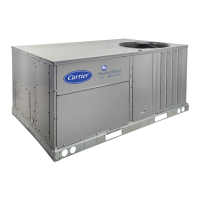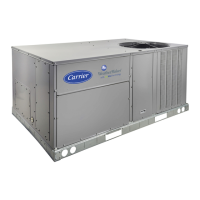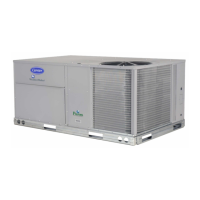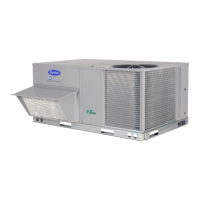STAGE
Table 73 -- Staged Gas Heat Control Steps (Configuration_HEAT_ SG.CT_HT.ST= 4)
RELAY OUTPUT
Heat 1
MBBIRLY8
IGC1
OFF
ON
ON
ON
ON
ON
ON
ON
ON
ON
ON
ON
Heat 2
MBB-RLY7
MGV1
OFF
OFF
ON
OFF
ON
ON
OFF
ON
OFF
OFF
ON
ON
CAPACITY
%
Heat 3
SCB-RLY1
IGC2
OFF
OFF
OFF
OFF
OFF
OFF
ON
ON
ON
ON
ON
ON
Heat 4
SCB-RLY2
MGV2
OFF
OFF
OFF
OFF
OFF
OFF
OFF
OFF
OFF
ON
ON
ON
Heat 5
SCB-RLY3
IGC3
OFF
OFF
OFF
ON
ON
ON
OFF
OFF
ON
ON
ON
ON
Heat 6
SCB-RLY4
MGV3
OFF
OFF
OFF
OFF
OFF
ON
OFF
OFF
OFF
OFF
OFF
ON
0 0
1 19
2 25
3 38
4 44
5 50
6 57
7 63
8 76
9 88
10 94
11 100
RELOCATE SAT (Supply Air Temperature) SENSOR FOR
HEATING IN LINKAGE APPLICATIONS -- On CCN in-
stallations employing ComfortID TM terminals, the factory SAT
location must be changed to a new location downstream of the
unit's heating system. The ComfortID terminal controls read
the SAT value for their "proof-of-heat" sequence before termi-
nals open to Minhnum Heating positions during unit heating
sequence.
Determine a location in the supply duct that will provide a
fairly uniform airflow. Typically this would be a minimum of
5 equivalent duct diameters downstream of the unit. Also, care
should be taken to avoid placing the thermistor within a direct
line-of-sight of the heating element to avoid radiant effects.
Run a new two-wire conductor cable from the control box
through the low voltage conduit into the space inside the build-
ing and route the cable to the new sensor location.
Installing a New Sensor -- A field-provided duct-mount tem-
perature sensor (Carrier P/N 33ZCSENPAT or equivalent
10 kilo-otnn at 25 C NTC [negative temperature coefficient]
sensor) is required. Install the sensor through the side wall of
the duct and secure.
Table 74 -- IGC LED Indicators
LED INDICATION
On
Off
1 Flash
2 Flashes
3 Flashes
4 Flashes
5 Flashes
6 Flashes
7 Flashes
8 Flashes
9 Flashes
NOTES:
ERROR CODE
Normal Operation
Hardware Failure
Fan On/Off Delay Modified
Limit Switch Fault
Fame Sense Fault
Five Consecutive Limit Switch Faults
Ignition Lockout Fault
Ignition Switch Fault
Rollout Switch Fault
Internal Control Fault
Software Lockout
1. There is a 3-second pause between error code displays.
2. If more than one error code exists, all applicable error codes
will be displayed in numerical sequence.
3. Error codes on the IGC will be lost if power to the unit is
interrupted.
Re-Using the Factory SAT Sensor -- The factory sensor is
attached to one of the supply fan housings. Disconnect the sen-
sor from the factory harness. Drill a hole insert the sensor
through the duct wall and secure in place.
Attach the new conductor cable to the sensor leads and ter-
minate in an appropriate junction box. Connect the opposite
end inside the unit control box at the factory leads from MBB
J8 terminals 11 and 12 (PNK) leads. Secure the unattached
PNK leads from the factory harness to ensure no accidental
contact with other terminals inside the control box.
MORNING WARM UP -- Morning Warm Up is a period of
time that assists CCN linkage in opening up downstream zone
dampers for the first heating cycle of a day.
The Morning Warm Up Period is CCN linkage mode "2"
and is relayed in the following conditions:
• Temperature Compensated Start Mode is active AND Heat
Mode in effect AND LAT is warm enough or is to be
ignored due to placement.
• The unit just went into occupied mode and there has been
no cooling mode yet and a heat cycle occurs or was in
progress when the unit went occupied.
In both cases, if and when the heat mode terminates, a heat
cycle has occurred and any subsequent heat cycles will not be
treated as a morning warm up period.
TEMPERING MODE -- In a vent or cooling mode, the roof-
top may encounter a situation where the economizer at mini-
1hum position is sending cold outside air down the ductwork of
the building. Therefore, it may be necessary to bring heat on to
counter-effect this low supply-air temperature. This is referred
to as the tempering mode.
Setting up the System -- The relevant set points for Temper-
ing are located at the local display under Setpoints:
ITEM
T.PRG
T.CL
T.V.OC
T.V.UN
CON
EXPANSION RANGE UNITS POINT
Tempering -20-80 dF TEMPPURG
Purge SASP
Tempering in 5-75 dF TEMPCOOL
Cool SASP
Tempering Vent -20-80 dF TEMPVOCC
Occ SASP
Tempering Vent -20-80 dF TEMPVUNC
Unocc. SASP
DEFAULT
5O
5
65
5O
Operation -- First, the unit must be in a vent mode, a low cool
mode, or a high cool HVAC mode to be considered for a tem-
pering mode. Secondly, the tempering mode is only allowed
when the rooftop is configured for staged gas (Configuration
--_HEA T--_HT. CF=3 ).
If the control is configured for staged gas, the control is in a
vent, low cool, or high cool HVAC mode, and the rooftop con-
trol is in a situation where the economizer must maintain a
minimum position, then the evaporator discharge temperature
(EDT) will be monitored. If the EDT falls below a particular
trip point then the tempering mode may be called out:
HVAC mode = "Tempering Vent"
56

